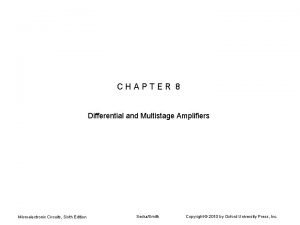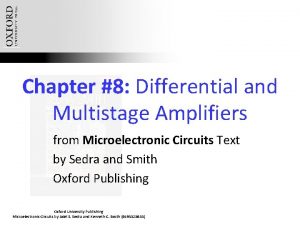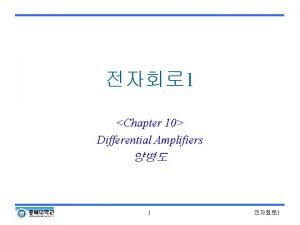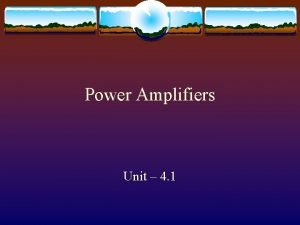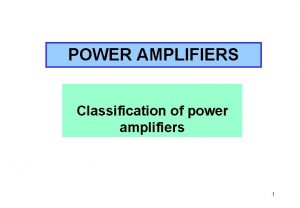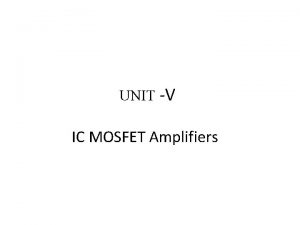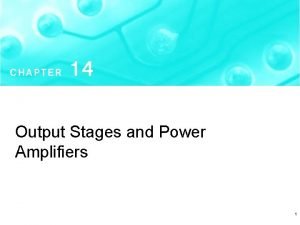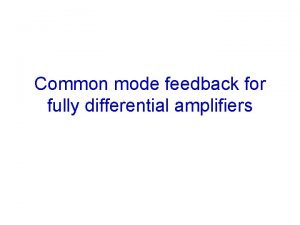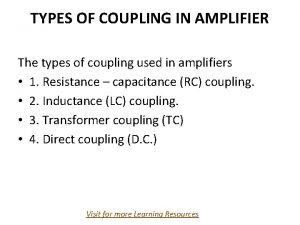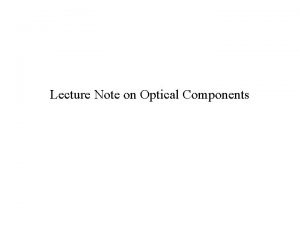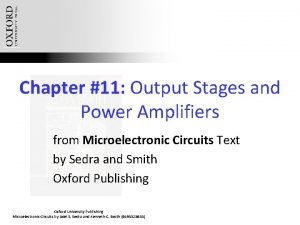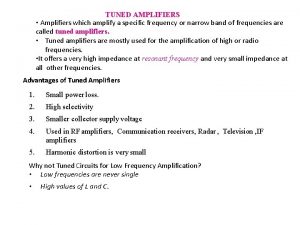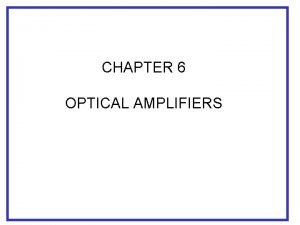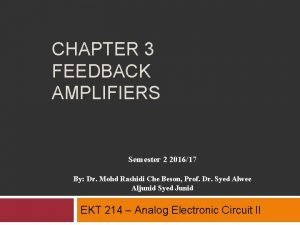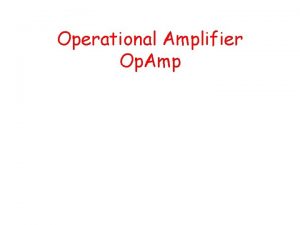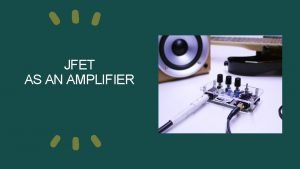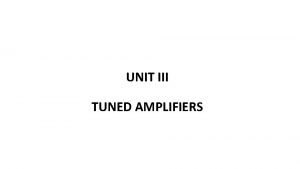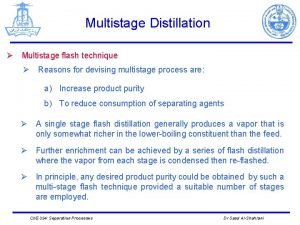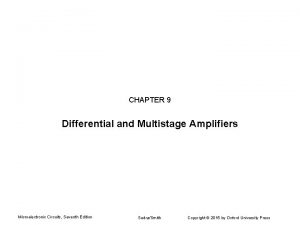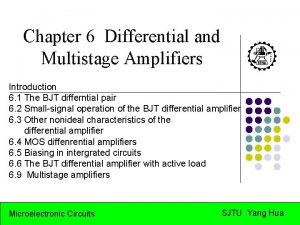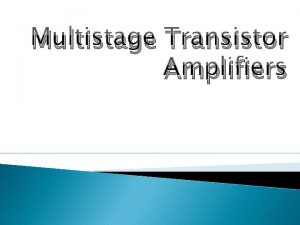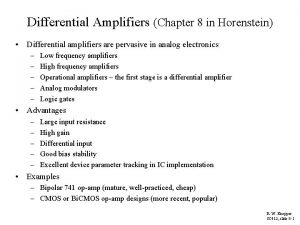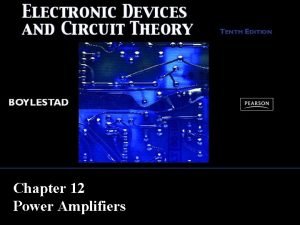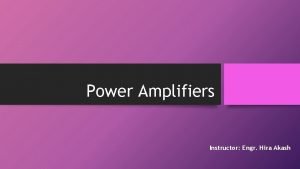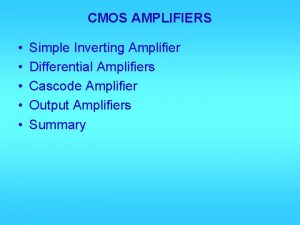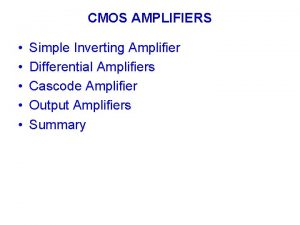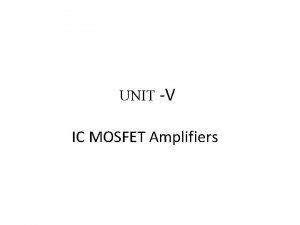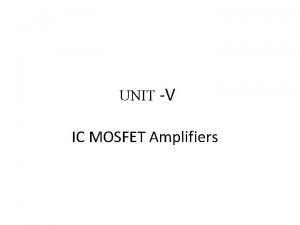MULTISTAGE AMPLIFIERS 1 Multistage Amplifiers Two or more






















- Slides: 22

MULTISTAGE AMPLIFIERS 1

Multistage Amplifiers Two or more amplifiers can be connected to increase the gain of an ac signal. The overall gain can be calculated by simply multiplying each gain together. A’v = Av 1 Av 2 Av 3 …… 2

Introduction n Many applications cannot be handle with single- transistor amplifiers in order to meet the specification of a given amplification factor, input resistance and output resistance n As a solution – transistor amplifier circuits can be connected in series or cascaded amplifiers n This can be done either to increase the overall small- signal voltage gain or provide an overall voltage gain greater than 1 with a very low output resistance 3

Multistage Amplifiers Multi-stage amplifiers are amplifier circuits cascaded to increased gain. We can express gain in decibels(d. B). Two or more amplifiers can be connected to increase the gain of an ac signal. The overall gain can be calculated by simply multiplying each gain together. A’v = Av 1 Av 2 Av 3 …… 4

Example Find Vout Vin = 5 m. V Av 1 = 5 Av 2 = 10 Av 3 = 6 Avn = 8 5

Multistage Amplifier Cutoff Frequencies and Bandwidth n When amplifiers having equal cutoff frequencies are cascaded, the cutoff frequencies and bandwidth of the multistage circuit are found using 6

Introduction (cont. ) Ø Multistage amplifier configuration: Cascade /RC coupling Cascode Q 2 Q 1 Transformer coupling 7 Darlington/Direct coupling

i) Cascade Connection -The most widely used method -Coupling a signal from one stage to the another stage and block dc voltage from one stage to the another stage -The signal developed across the collector resistor of each stage is coupled into the base of the next stage -The overall gain = product of the individual gain 8 **refer page 219

i) Cascade Connection (cont. ) Ø small signal gain is: by determine the voltage gain at stages 1 & stage 2 therefore - the gain in d. B Ø input resistance Output resistance - assume , so also Therefore 9

Exercise 1: Draw the ac equivalent circuit and calculate the voltage gain, input resistance and output resistance for the cascade BJT amplifier in above Figure. Let the parameters are: 10

Solution 1 (cont. ): Ac equivalent circuit for cascade amplifier 11

Solution 1: DC analysis: At Q 1: At Q 2: AC analysis: At Q 1: Why the Q-point values same for both Q 1 & Q 2 ? At Q 2: 12

Solution 1 (cont. ): From the ac equivalent circuit: At Q 1, the voltage gain is: Where and is the o/p voltage looking to the Q 1 transistor is the i/p resistance looking into Q 2 transistor Therefore The voltage gain at Q 1 is: 13

Solution 1 (cont. ): From the ac equivalent circuit: At Q 2, the voltage gain is: Where is the i/p voltage looking into the Q 2 transistor Therefore, the voltage gain at Q 2 is: The overall gain is then, ** The large overall gain can be produced by multistage amplifiers!! So, the main function of cascade stage is to provided the larger overall gain 14

Solution 1 (cont. ): From the ac equivalent circuit: The i/p resistance is: The o/p resistance is: 15

ii) Cascode Connection -A cascode connection has one transistor on top of (in series with) another -The i/p into a C-E amp. (Q 1) is, which drives a C-B amp. (Q 2) -The o/p signal current of Q 1 is the i/p signal of Q 2 -The advantage: provide a high i/p impedance with low voltage gain to ensure the i/p Miller capacitance is at a min. with the C-B stage providing good high freq. operation **refer page 223 16

ii) Cascode Connection (cont. ) From the small equivalent circuit, since the capacitors act as short circuit, by KCL equation at E 2: solving for voltage Where the output voltage is or 17

ii) Cascode Connection (cont. ) Therefore the small signal voltage gain: From above equation shows that: So, the cascode gain is the approximately * The gain same as a single-stage C-E amplifier 18

iii) Darlington Connection -The main feature is that the composite transistor acts as a single unit with a current gain that is the product of the current gains of the individual transistors -Provide high current gain than a single BJT -The connection is made using two separate transistors having current gains of and So, the current gain If The Darlington connection provides a current gain of Figure 1: Darlington transistor 19

iii) Darlington Connection (cont. ) Ø Figure shown a Darlington configuration refer page 222 20

iii) Darlington Connection (cont. ) Ø The small current gain : Since Therefore Then, The o/p current is: The overall gain is: ** The overall small-signal current gain = the product of the individual current gains 21

iii) Darlington Connection (cont. ) Ø The input resistance: Known that: So, the i/p resistance is: The base of Q 2 is connnected to the emitter of Q 1, which means that the i/p resistance to Q 2 is multiplied by the factor , as we saw in circuits with emitter resistor. So, we can write: and Therefore The i/p resistance is then approximately 22 **The i/p resistance tends to be large because of the multiplication
 Lirik lagu more more more we praise you
Lirik lagu more more more we praise you More more more i want more more more more we praise you
More more more i want more more more more we praise you Differential and multistage amplifiers
Differential and multistage amplifiers Differential and multistage amplifiers
Differential and multistage amplifiers Differential and multistage amplifiers
Differential and multistage amplifiers Classification of power amplifiers
Classification of power amplifiers Classification of power amplifiers
Classification of power amplifiers A cs amplifier utilizes a mosfet with
A cs amplifier utilizes a mosfet with Isolated instrumentation amplifier
Isolated instrumentation amplifier Vbe multiplier circuit
Vbe multiplier circuit Common mode feedback
Common mode feedback Amplifier
Amplifier Optical amplifiers lecture notes
Optical amplifiers lecture notes Class b output stage
Class b output stage Advantages of tuned amplifier
Advantages of tuned amplifier In-line optical dwdm amplifiers
In-line optical dwdm amplifiers Current feedback
Current feedback Ideal opamp
Ideal opamp Operational amplifier is also called as
Operational amplifier is also called as Amplification factor in jfet
Amplification factor in jfet Series shunt feedback
Series shunt feedback Single tuned amplifier derivation of quadratic formula
Single tuned amplifier derivation of quadratic formula Angels in amplifiers
Angels in amplifiers


